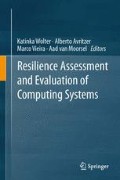Abstract
In order to be resilient, a network must possess means to ensure connectivity even in the presence of disturbances. This chapter will study two different approaches to increase resilience of mobile networks, in the context of the handover procedure. Seamless handovers between base stations is a prerequisite for service continuity in mobile networks. The handover process consists in handing off a call to a new base station when the mobile user moves to its corresponding cell while the call is in progress. It imposes frequency synchronicity requirements which imply strict bounds on the tolerable frequency deviations of base-station clocks. The preferred protocol for frequency synchronisation in packet-switched backhaul networks is the Precision Time Protocol (PTP). In the first part of this chapter, the suitability of backhaul networks for accurate frequency synchronisation using PTP is investigated. Two solutions for improving accuracy are derived. While the first is applicable to networks of any topology, but may require costly reconfiguration, the second is limited to specific setups, but can be applied without changing the network. The second part of this chapter is dedicated to the performance analysis of a Markov-based prediction model. Mobility prediction constitute an important solution to enable seamless handovers in cellular networks. The mobility trace is the main information used to perform mobility prediction. However, using solely this information makes the prediction process difficult when the mobile user is new in the network, that is, when its mobility trace is poor. The efficiency of the prediction model relies on both the ability of the model to predict successfully the next move of a mobile user and its ability to perform such a prediction in a short delay. In order to assess the Markov-based prediction model, data sets of a real cellular network in a major US urban area are used.
Access this chapter
Tax calculation will be finalised at checkout
Purchases are for personal use only
Notes
- 1.
To illustrate: a frequency of \(2\,\text{GHz} = 2 \times 10^9/\text{s}\) may vary in the range \([2\times 10^9 \pm 100]\) per second.
- 2.
The main difference between master and slave is the quality of the oscillator and hence the clocks’ frequency stability.
- 3.
Note that base stations of an FDD-RAN typically have no need for phase synchronisation or time-of-day synchronisation.
- 4.
Parts per billion, defined as \(10^{-9}\).
- 5.
Note that there exist different terminologies and definitions for the variation in transmission delays (sometimes also referred to as jitter), e.g. the instantaneous PDV, as defined by [284].
- 6.
We refer the reader to [939] for details and only mention here that this upper bound corresponds to a maximum deviation of 15 ppb and an integration window size of 4 h.
Acknowledgments
Samir Bellahsene and Leïla Kloul are supported by the European Celtic project HOMESNET [8]. Katinka Wolter and Philipp Reinecke are supported by the German Research Council under grant Wo 899/2-1. They would like to thank highstreet technologies GmbH and Alfons Mittermaier for the provided insights into frequency synchronisation techniques.
Author information
Authors and Affiliations
Corresponding author
Editor information
Editors and Affiliations
Rights and permissions
Copyright information
© 2012 Springer-Verlag Berlin Heidelberg
About this chapter
Cite this chapter
Bellahsene, S., Kloul, L., Reinecke, P., Wolter, K. (2012). Case Study: Mobile Networks. In: Wolter, K., Avritzer, A., Vieira, M., van Moorsel, A. (eds) Resilience Assessment and Evaluation of Computing Systems. Springer, Berlin, Heidelberg. https://doi.org/10.1007/978-3-642-29032-9_17
Download citation
DOI: https://doi.org/10.1007/978-3-642-29032-9_17
Published:
Publisher Name: Springer, Berlin, Heidelberg
Print ISBN: 978-3-642-29031-2
Online ISBN: 978-3-642-29032-9
eBook Packages: Computer ScienceComputer Science (R0)

